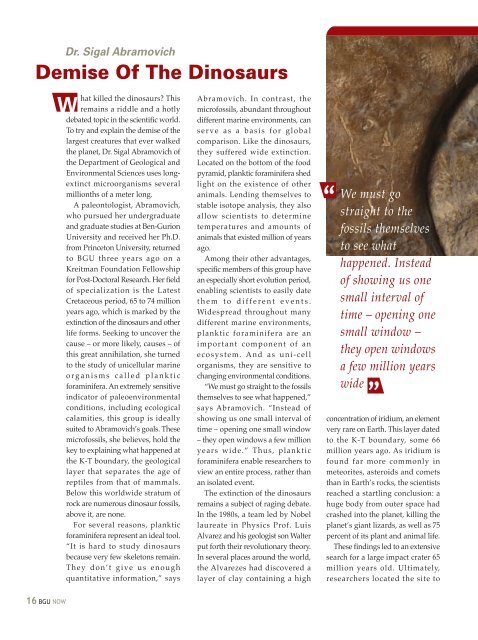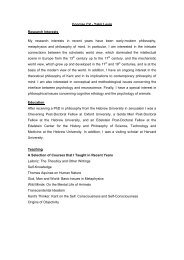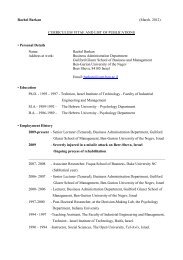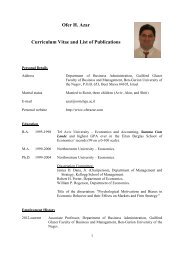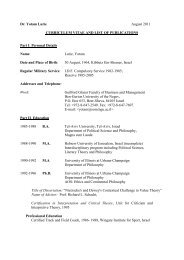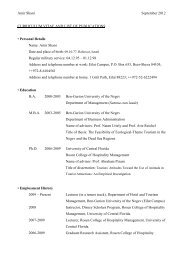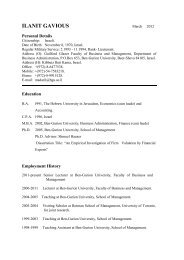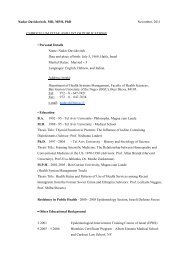cover 2006
cover 2006
cover 2006
Create successful ePaper yourself
Turn your PDF publications into a flip-book with our unique Google optimized e-Paper software.
Dr. Sigal Abramovich<br />
Demise Of The Dinosaurs<br />
16 BGU NOW<br />
W<br />
hat killed the dinosaurs? This<br />
remains a riddle and a hotly<br />
debated topic in the scientific world.<br />
To try and explain the demise of the<br />
largest creatures that ever walked<br />
the planet, Dr. Sigal Abramovich of<br />
the Department of Geological and<br />
Environmental Sciences uses longextinct<br />
microorganisms several<br />
millionths of a meter long.<br />
A paleontologist, Abramovich,<br />
who pursued her undergraduate<br />
and graduate studies at Ben-Gurion<br />
University and received her Ph.D.<br />
from Princeton University, returned<br />
to BGU three years ago on a<br />
Kreitman Foundation Fellowship<br />
for Post-Doctoral Research. Her field<br />
of specialization is the Latest<br />
Cretaceous period, 65 to 74 million<br />
years ago, which is marked by the<br />
extinction of the dinosaurs and other<br />
life forms. Seeking to un<strong>cover</strong> the<br />
cause – or more likely, causes – of<br />
this great annihilation, she turned<br />
to the study of unicellular marine<br />
organisms called planktic<br />
foraminifera. An extremely sensitive<br />
indicator of paleoenvironmental<br />
conditions, including ecological<br />
calamities, this group is ideally<br />
suited to Abramovich’s goals. These<br />
microfossils, she believes, hold the<br />
key to explaining what happened at<br />
the K-T boundary, the geological<br />
layer that separates the age of<br />
reptiles from that of mammals.<br />
Below this worldwide stratum of<br />
rock are numerous dinosaur fossils,<br />
above it, are none.<br />
For several reasons, planktic<br />
foraminifera represent an ideal tool.<br />
“It is hard to study dinosaurs<br />
because very few skeletons remain.<br />
They don’t give us enough<br />
quantitative information,” says<br />
Abramovich. In contrast, the<br />
microfossils, abundant throughout<br />
different marine environments, can<br />
serve as a basis for global<br />
comparison. Like the dinosaurs,<br />
they suffered wide extinction.<br />
Located on the bottom of the food<br />
pyramid, planktic foraminifera shed<br />
light on the existence of other<br />
animals. Lending themselves to<br />
stable isotope analysis, they also<br />
allow scientists to determine<br />
temperatures and amounts of<br />
animals that existed million of years<br />
ago.<br />
Among their other advantages,<br />
specific members of this group have<br />
an especially short evolution period,<br />
enabling scientists to easily date<br />
them to different events.<br />
Widespread throughout many<br />
different marine environments,<br />
planktic foraminifera are an<br />
important component of an<br />
ecosystem. And as uni-cell<br />
organisms, they are sensitive to<br />
changing environmental conditions.<br />
“We must go straight to the fossils<br />
themselves to see what happened,”<br />
says Abramovich. “Instead of<br />
showing us one small interval of<br />
time – opening one small window<br />
– they open windows a few million<br />
years wide.” Thus, planktic<br />
foraminifera enable researchers to<br />
view an entire process, rather than<br />
an isolated event.<br />
The extinction of the dinosaurs<br />
remains a subject of raging debate.<br />
In the 1980s, a team led by Nobel<br />
laureate in Physics Prof. Luis<br />
Alvarez and his geologist son Walter<br />
put forth their revolutionary theory.<br />
In several places around the world,<br />
the Alvarezes had dis<strong>cover</strong>ed a<br />
layer of clay containing a high<br />
We must go<br />
straight to the<br />
fossils themselves<br />
to see what<br />
happened. Instead<br />
of showing us one<br />
small interval of<br />
time – opening one<br />
small window –<br />
they open windows<br />
a few million years<br />
wide<br />
concentration of iridium, an element<br />
very rare on Earth. This layer dated<br />
to the K-T boundary, some 66<br />
million years ago. As iridium is<br />
found far more commonly in<br />
meteorites, asteroids and comets<br />
than in Earth’s rocks, the scientists<br />
reached a startling conclusion: a<br />
huge body from outer space had<br />
crashed into the planet, killing the<br />
planet’s giant lizards, as well as 75<br />
percent of its plant and animal life.<br />
These findings led to an extensive<br />
search for a large impact crater 65<br />
million years old. Ultimately,<br />
researchers located the site to


